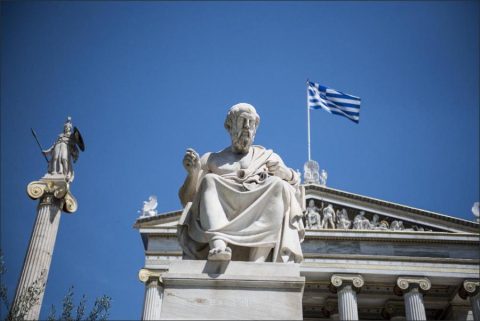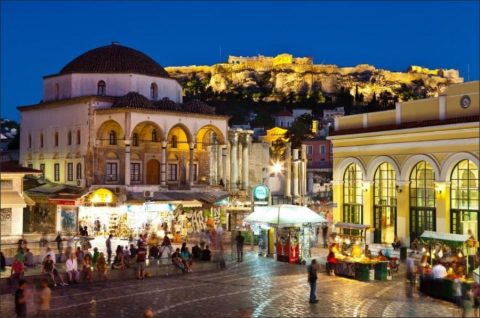Athens after the fall of the Thirty in 403 and during the early years of the Second Confederacy must have been on the whole a place of buoyancy and optimism. There was, it is true, great poverty after the Peloponnesian War, and the last two plays of Aristophanes show that it extended to the country as well as the town; it is true also that the comic poets (and therefore presumably a considerable or at least an influential part of their audiences) criticised the new forward policy, Conon’s command of the Persian fleet and the formation of the Second Athenian Confederacy.
But Athens had lost far less of her position through war, revolution, and counter-revolution than had seemed likely, and Isocrates’ Panegyricus, in which he called upon Athens and Sparta to forget their jealousies and make common cause against Persia, is probably a fair statement of Athenian optimism in the eighties. One sentence expresses briefly the Athenian claim: ‘Our city has so far surpassed the rest of mankind in wisdom and its expression that her disciples have become the teachers of the world; the name of Greek no longer denotes a race but a kind of intellect, and men are called Greek rather because they share Athenian education than because of community of blood.’
If this is true, what evidence can we see for an international Greek culture centred on Athens and what was its quality? Isocrates himself addressed rulers all over the Greek world. Plato had relations with Megara and Thebes, with Sicily and South Italy. The tragic poet had to make his name in Athens before he could produce successfully in other Greek cities; we know that Dionysius of Syracuse tried repeatedly to have his tragedies performed in Athens, and the successful comic poet Antiphanes was apparently not an Athenian citizen; moreover vases already show evidence of the export of both tragedy and comedy to the Greek cities in South Italy. The Sicyonian painter Pamphilus had painted in Athens before 387, and the Athenian sculptor Cephisodotus worked in Megalopolis and Thebes as well as Athens.
In his summary of the benefits which Athens has given mankind Isocrates first names agriculture and the Mysteries, then speaks of Athens as a centre of colonisation, of the benefits of the rule of law, and of the advantages of the Peiraeus as a central market; he calls Athens a ‘festival city’, and finally personifies Philosophy, ‘who helped in the discovery and the execution of all this, who educated us to action and made us kind to each other, and distinguished between necessary evils and evils which arise from our own folly’.
It is not a bad picture of the Athenian spirit, and the equation of humanity and discrimination with discovery and execution is characteristic of Isocrates’ time: Pericles in the Funeral Speech had emphasised speed and brilliance more than tolerance, but Isocrates is essentially developing the Periclean ideal. He goes on to discuss eloquence as the distinctive mark of this civilisation and here he is thinking particularly of his own school. A practical school for politicians was a new idea and an attempt to meet the political conditions of the time. It sounds to us both unreal in so far as it was based on a superficial knowledge of local history and too realistic in its concentration on the technique of speaking, but it was probably much better than anything that had preceded it.
In his speech Against the Sophists Isocrates clearly distinguishes his position both from those who profess instruction in political eloquence, whom he charges with making their pupils learn model speeches by heart instead of exercising them, and from Plato. We should surely see a reference to Plato’s discussions in the early dialogues of happiness, virtue, and temperance, when Isocrates attacks the professors of Eristic who ‘are so bold that they try to persuade the young that if they come to them they will know what is to be done and this knowledge will make them happy’.
Similarly, we may see an allusion to Plato’s Ideal State in the Egyptian caste system described in the Busiris and a further allusion to the Socratic ethics of the early dialogues in the early part of the Helen. Nothing in these attacks goes beyond the reasonable rivalry of men who were competing for the same pupils and had fundamentally different ideas on the subject-matter of instruction. For Isocrates Plato was pretending to do something which could not be done; for Plato Isocrates was on the border-line between philosophy and politics and got the worst of both worlds.
One permanent result however Isocrates did achieve. The conception of leisured educated prose discussing serious issues against a background of tradition originated with him. His style is a development of the style of Gorgias. Gorgias in the late fifth century had captivated his audiences by a highly artificial prose; its vocabulary was poetical and its clauses held together by parallelism of structure and antithesis. Isocrates loosened this up into what he called a ‘flowery and gracious style’. He preserved the poetic flavour by avoiding hiatus and introducing frequent rhythmical elements particularly at the ends of paragraphs. While abandoning the extreme constriction of Gorgias’ parallel and antithetic clauses, he preserves their structure as the basis of a larger fabric. Isocrates loves pairs of sentences, clauses, phrases, and words, connected by corresponsive particles, and this elaboration by the paratactic construction of pairs rather than by the hypotactic use of clauses and participial phrases gives his sentences an entirely different structure from those of Lysias and Demosthenes. The principle is simple: every sentence and clause is divided into two antithetic halves, and each succeeding antithesis must depend on or be subordinate to that immediately preceding it, so that the result is a chain of small balanced parts, which may be of any length. The other marked characteristic of his style is the padding out of simple grammatical terms by the addition of synonyms or near-synonyms. The style succeeds because the few rather simple ideas of Isocrates are absorbed by the audience while they are enjoying the construction of the chains of antithetic phrases.
This style can reasonably be compared with the so-called rich style of contemporary vase-painting and sculpture, in which we can trace the same kind of development as that which leads from Gorgias to Isocrates. Obvious examples in sculpture are the balustrade of the temple of Athena Nike in Athens from the late fifth century and the acroteria of the temple at Epidaurus from the early fourth. The Victories of the Nike temple have their garments arranged in an elaborate pattern of tiny folds; the drapery of the Epidaurus figures is freer and less constricted but still the formal pattern is dominant and clear. The colour has gone from these sculptures, and we do not know how much it added to their richness; for that we must turn to vase-painting where we can see the rich style in the Meidias painter, who started painting in the last quarter of the fifth century, and in his successors, who continue to the end of the first quarter of the fourth. The clothes in painting too are immensely elaborate and their surfaces are either cut up into a multitude of tiny folds or covered with elaborate patterns. Moreover to the normal black of the background and red of the clay are added white for the flesh of women and Erotes and gold for their necklaces, bracelets, hair-ornaments, and other appurtenances.
In subject-matter as well as style Isocrates shows an affinity with contemporary art, since we can trace from the late fifth century a patriotic art which glorifies the past of Athens in the same spirit as the Panegyricus. Isocrates develops there a strain of thought which can be seen in some of the plays of Euripides, particularly Suppliants, Erechtheus, and Ion, and was probably the conception of Athens put forward by politicians like Theramenes, who believed in the ‘ancestral polity’. Attic legends always figured on Attic vases and there is nothing new in pictures of Erichthonius and Cecrops, of Theseus, or even of Triptolemus. It is however interesting that on the well-known hydria with the rape of the Leucippids in the British Museum the Meidias painter adds to the Argonauts who accompany Heracles to the garden of the Hesperides the Attic tribal heroes Antiochus, Oineus, Akamas, Hippothon and Demophon.
The expedition of the Argonauts has become a partly Athenian enterprise and a mythical ancestor for Attic colonisation (or, as we are accustomed to say, the Ionian migration), which Isocrates praises in the Panegyricus. On a pelike in New York the same painter draws the poet Musaeus with Aphrodite and the Muses and by his side is Deiope with the infant Eumolpus. Deiope is an Attic heroine and Eumolpus figures constantly in pictures of the Eleusinian gods.
Musaeus is here brought into the Eleusinian genealogy and his marriage is blessed by Aphrodite and the Muses. Musaeus and his son according to Plato assured the just a life of eternal drunkenness and provided a Hell for the unjust. It may be that the idea of reward and punishment for moral as distinct from ritual purity and impurity was introduced into the Eleusinian Mysteries in the late fifth century, and this may be the significance of bringing Musaeus into relation with the Mysteries. Possibly therefore we have in this vase evidence for the introduction into the Mysteries of a new strain of thought; certainly the association of Musaeus and the Muses with Eumolpus is a glorification of the Mysteries in the spirit of Isocrates.
The young knight Dexileos, who was killed in the war against Corinth in 394, had in his grave an oenochoe with a picture of the statues of the Tyrant-slayers, and we know several similar representations on vases of the late fifth and early fourth centuries. Athens at this time consciously recalled the great second founding of the democracy, which produced the heroes of the Persian War.
The watchword of the new democracy was homonoia, which meant primarily the agreement between the aristocrats and the democrats within the Athenian state (and was thus the ancestor of Cicero’s concordia ordinum), but Isocrates widened it to mean agreement between the Greek states themselves. An obvious symbol of this external homonoia is Cephisodotus’ statue of Eirene holding the infant Plutus, which is believed to have been erected in celebration of the abortive peace with the Spartans in 373, 3 an event also celebrated by the comic poet Theopompus in his Peace.
In the comedy we can assume that Eirene, the personification of the peace so desperately needed that the Athenians deified her by decreeing her yearly sacrifices, spoke the prologue; a papyrus fragment which describes the frock of a bride whose wedding gifts are not gold or emerald but wisdom and justice is written in the same spirit, although we cannot say that it comes from this play. So also in the Ecclesiazusae Aristophanes speaks of Salvation (soteria) showing her face for a moment during the Corinthian war.
This idea of homonoia is symbolised in art by the pictures joining together two gods who normally belong to different spheres. Apollo and Dionysus had shared the temple at Delphi long before this time, but now they were represented together in art; Apollo greets Dionysus and his thiasos at Delphi, or is served with food and drink by satyrs and maenads while the young Dionysus looks on. On another vase the young Heracles is reconciled to Apollo with the approval of Hera and Artemis, and on yet another Dionysus holds a symposium with the young Hephaestus. The painters represent homonoia in heaven to symbolise the homonoia which is so much desired on earth.
Hits: 108


